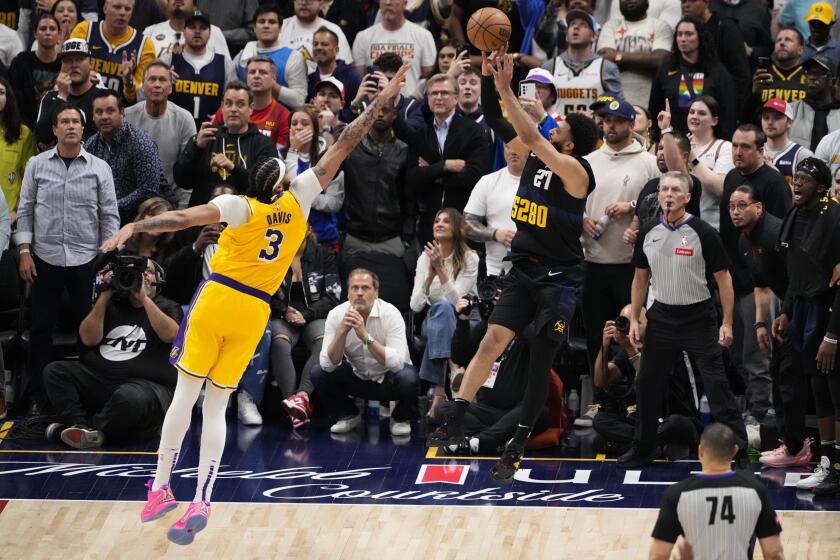Haitians take comfort and find hope in soccer
Two years after a deadly earthquake knocked Haiti to its knees, signs of progress can be hard to come by.
More than half a million homeless still live in squalid camps rife with violence. The cholera epidemic that ravaged the country after the disaster continues to kill. And despite the best efforts of the newly elected government, only half the rubble choking the once-teeming streets of Port-au-Prince has been cleared.
Yet amid the mind-numbing devastation, Patrice Dumont finds hope in the simple act of a young boy kicking a ball.
“Every time I feel very weak and hopeless, I get boosted by the courage of the kids playing soccer on the streets,” says Dumont, Haiti’s most respected soccer commentator.
And he is not alone among Haitians, many of whom find comfort in the resilience of their national pastime when comfort is otherwise hard to find.
The country lost at least 30 soccer coaches, players and administrators in the earthquake — many in the collapse of the rented three-story concrete-block building that housed the national soccer federation. Among those who perished was Yves Philogene Labaze, the popular and successful coach of Haiti’s U-17 team. Two years after the quake, Dumont says, a complete list of who died in the building has not been released.
“It’s painful every time we talk of what happened,” says federation President Yves Jean-Bart, one of just two people to scurry safely out of the building as it collapsed. “But we’re remaking everything.”
To truly appreciate how far Haiti has come, however, you must first understand how far it had fallen.
In 2007, the country won its first Caribbean Cup and climbed to 66th in the FIFA world rankings, its best mark ever. Yet by last fall, 20 months after the earthquake, it was enduring an embarrassing loss to Antigua in the second round of World Cup qualifying, and many of its top players — including 22-year-old Sony Norde, who joined Argentina’s Boca Juniors; La Liga veteran Frantz Bertin; and San Jose Earthquakes midfielder Jean Alexandre — had fled the country to play elsewhere.
The Haitian U-17 team, which had played well under Labaze in the previous World Cup, was humiliated by being quarantined, then expelled, from a qualifying tournament in Jamaica after a cholera scare last February. And the women’s team saw its world ranking drop to 106, its worst ever, within three months of the quake.
The national soccer federation, financially strapped in the best of times, was broke. So FIFA, international soccer’s governing body, set up a $3-million fund, and FIFA officials individually donated nearly $1 million more.
Thanks to such largess, the national federation’s headquarters has been rebuilt, and there is a modern new national training center and a new technical center. The 54-year-old Sylvio Cator national stadium — heavily damaged by the quake and, like many stadiums around the country, later used as a refugee camp — is now the site of regular practices.
“Competition is back. The players are back training. The clubs are playing championships,” says Philippe Vorbe, a midfielder on Haiti’s legendary 1974 World Cup team. “But the level is very low. So it’s almost starting from scratch again.”
But, he continues, “we are coming back.”
It’s a comeback that gained momentum last week when the threadbare women’s national team not only beat Cuba but also won over a city during the Olympic qualifying tournament in Vancouver. Local Canadian clubs raised money and donated uniforms, and restaurants provided free meals to the Haitians, many of whom saw snow for the first time while in Vancouver.
At the team’s final game, one young fan held up a sign that read: “You inspire us, Team Haiti.”
“It is satisfying that, with so many problems with materials, with financial problems, we still finished well,” Jean-Bart says. “We left a good impression. Haiti is back on its feet, and we’re continuing to work.”
Dumont believes it will take another decade to get Haitian soccer back to where it was before the quake, pointing out that the club teams he favors, Valencia and Cavaly, still play on fields made up primarily of dirt clods. And fans must stand on the sidelines and cheer because the bleachers have yet to be rebuilt.
Yet stand — and cheer — they do because soccer is no longer just a sport in Haiti. It’s a reminder that though the earthquake had the power to take lives and flatten buildings, there were other things it could not touch.
“Fortunately the quake was not strong enough to destroy our love of the game and our soul,” Dumont says.
“Soccer is nearly a religion,” Jean-Bart adds in Spanish during a phone call from Port-au-Prince. “Sometimes I’ll read that Brazil and other countries have more passion for soccer; the people are more fanatical. I don’t think there’s another country in the world where there’s more passion, more love for soccer.
“Soccer is everything here.”
More to Read
Get our high school sports newsletter
Prep Rally is devoted to the SoCal high school sports experience, bringing you scores, stories and a behind-the-scenes look at what makes prep sports so popular.
You may occasionally receive promotional content from the Los Angeles Times.







